The lawn may be the largest part of your garden landscape. From seeding and mowing to weeding and raking autumn leaves, you do your best to keep it looking lush and lovely, and take pride in the accomplishment.
And once those leaves are cleared away, it’s goodbye to lawn chores until spring, right?
Wrong.
Even when turf is dormant during the coldest months of the year, it can benefit from a bit of care and attention.
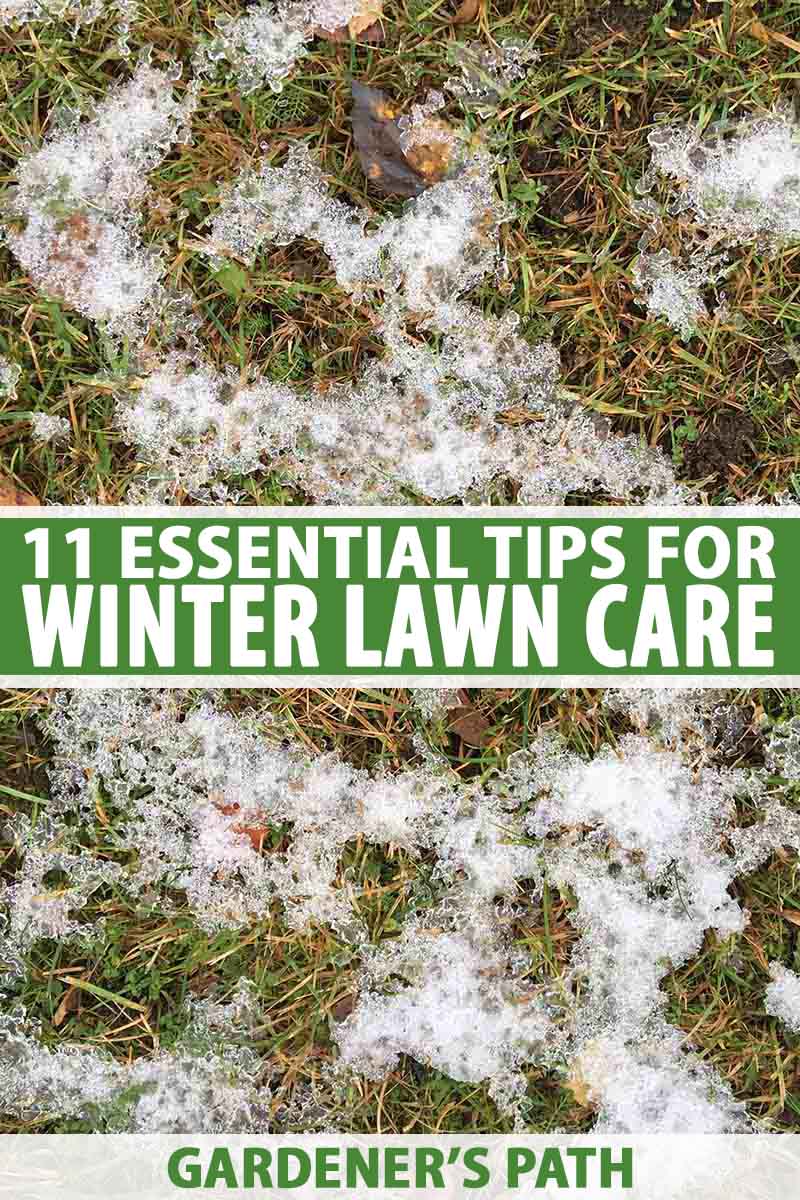
We link to vendors to help you find relevant products. If you buy from one of our links, we may earn a commission.
Depending on where you live, your lawn may be comprised of warm season grass, like zoysia and Bermuda, or cool-season varieties, such as fescue, Kentucky blue, and perennial rye.
Warm season grass grows in spring and summer, and turns the color of straw in cold weather. Cool season turf does most of its growing in spring and fall, and retains some or all of its green hue through the coldest months.
In this article, you will learn 11 ways to care for your lawn in winter to keep it healthy, and give you a jump-start on the next growing season.
Winter Lawn Care Essentials
1. Aerating
The soil underneath the grass has a tendency to become very compacted, from heavy foot traffic or the weight of machinery, such as that used in home building and landscaping. This can cause the soil to dry out, and lead to poor nutrient uptake by grass roots, as well as drainage problems in the landscape.

In addition, the layer of living material and debris between the soil and the visible grass is called “thatch.” A thickness of up to one inch of thatch is characteristic of a healthy lawn. More than that may block air and water penetration, reducing nutrient uptake and contributing to drainage issues.
The solution to both soil compaction and excess thatch is aeration. This is a process of making holes down through the turf and into the soil below, to introduce air and allow water to penetrate.
It can be done with a manual or power aerating tool, which may be of either the plug or spike type.
A power plug aerator churns up pellets of earth, slicing through thatch and compacted earth, bringing up nutrients from the soil below and depositing them onto the surface, where the next rain or snow washes them back down to nourish the grass.
The spike type pokes holes into the ground, effectively breaking up the thatch, introducing air, and improving drainage. It’s not quite as effective because it doesn’t bring up plugs of nutrient-rich earth to the surface to feed the turf.
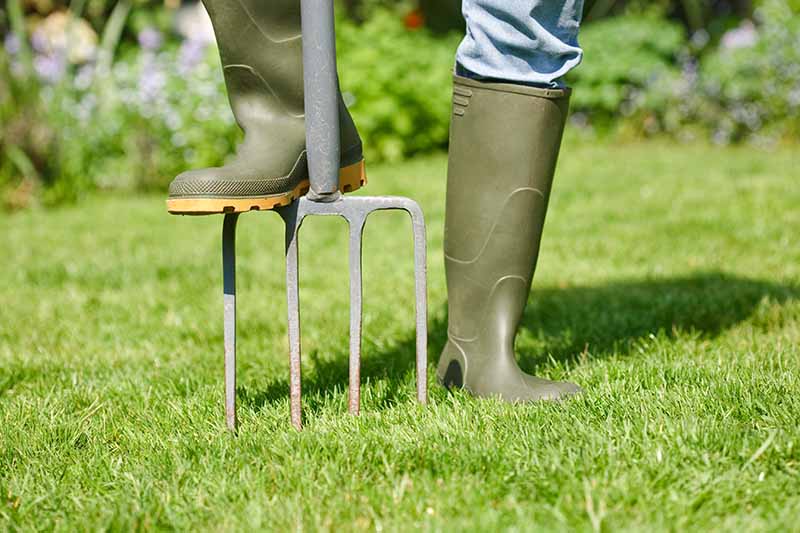
For my small patch of lawn, I use a pitch fork, stepping on it as I go along, to poke holes down through the grass and into the soil.
The spikes cut through the thatch, increase airflow, and improve drainage.
The improved drainage achieved through aeration helps to prevent a condition called “crown hydration,” in which grass takes up water on a warmer day, only to have it freeze inside its cells and rupture them, due to poor drainage.
Breaking through thatch to promote drainage also inhibits the development of “snow molds” during snow melting. These fungal infections stain the grass pink (Fusarium patch) or gray (Typhula blight), as they kill the blades, crowns, and roots, weakening or killing grass plants.
Aerating is a chore you can easily perform in the warmer months. However, if you haven’t had a chance, don’t let cold temperatures stop you. As long as the ground isn’t frozen, it is easily accomplished.
2. Avoiding Salt Damage
De-icing products that contain salt may damage nearby grass by leaching into it. This is likely to cause “physiological drought,” a condition that impedes nutrient uptake and creates bare spots.
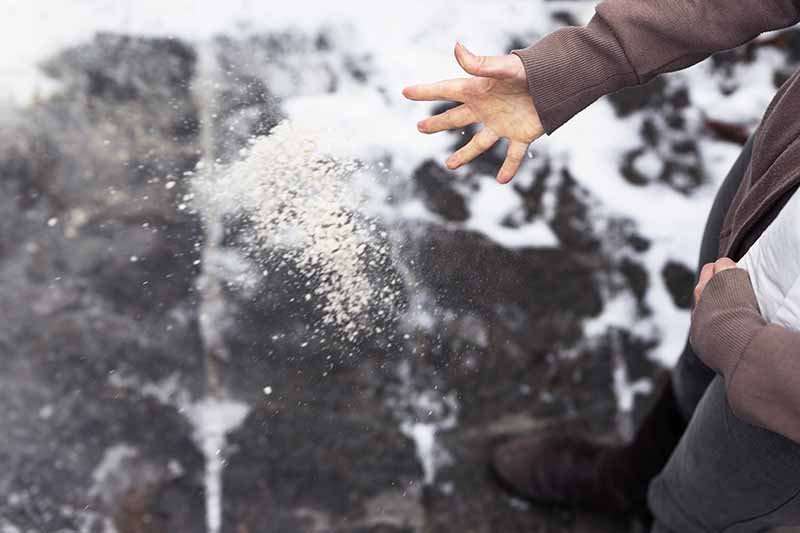
If you have to treat walkways across or near the edges of your lawn, choose products made with sodium chloride alternatives, such as calcium chloride.
In addition, when you shovel the front sidewalks after a snowfall, be sure not to pile the white stuff on the grass, as it may contain residue from roadway treatments.
If you are aware of salt spray and melt runoff coming into contact with your turf, be sure to water your lawn deeply as soon as ground temperatures are above freezing, as indicated by a soil thermometer. This will help to flush the salt out and minimize damage.
Also, don’t leave bags of de-icing salt on or near turf areas, as they may leach salt into the soil.
3. Fertilizing
Similarly, if the ground isn’t frozen, winter is the perfect time to sweeten acidic soil with a little lime. You can determine your soil’s pH with a soil test.

You can also apply a “winterizing” slow-release fertilizer. This is an excellent way to hit the ground running with well-nourished spring shoots.
4. Maintaining Equipment
If you didn’t have time to do it in the fall, give your mower a good cleaning and tightening. Repair or replace parts as needed.
Now is a good time to sharpen the mower blades so they can cut cleanly. Dull ones can tear rather than cutting the grass cleanly, leaving grass blades jagged and susceptible to disease, or even tear the crowns away from the roots, leaving bare patches.
Check your height adjustment gear. The ability to raise and lower the cutting deck can make the difference between a lawn that survives a drought, and one that burns off because it was scalped.
Follow the maintenance instructions for your type of mower. For example, if it’s gas-powered, add fuel stabilizer and drain the gas. Store it in a dry, protected place until you’re ready to fire it up in spring.
5. Minimizing Soil Compaction
As mentioned, the compaction of the earth below the turf reduces its ability to nourish the grass, and may lead to drying out and drainage issues.
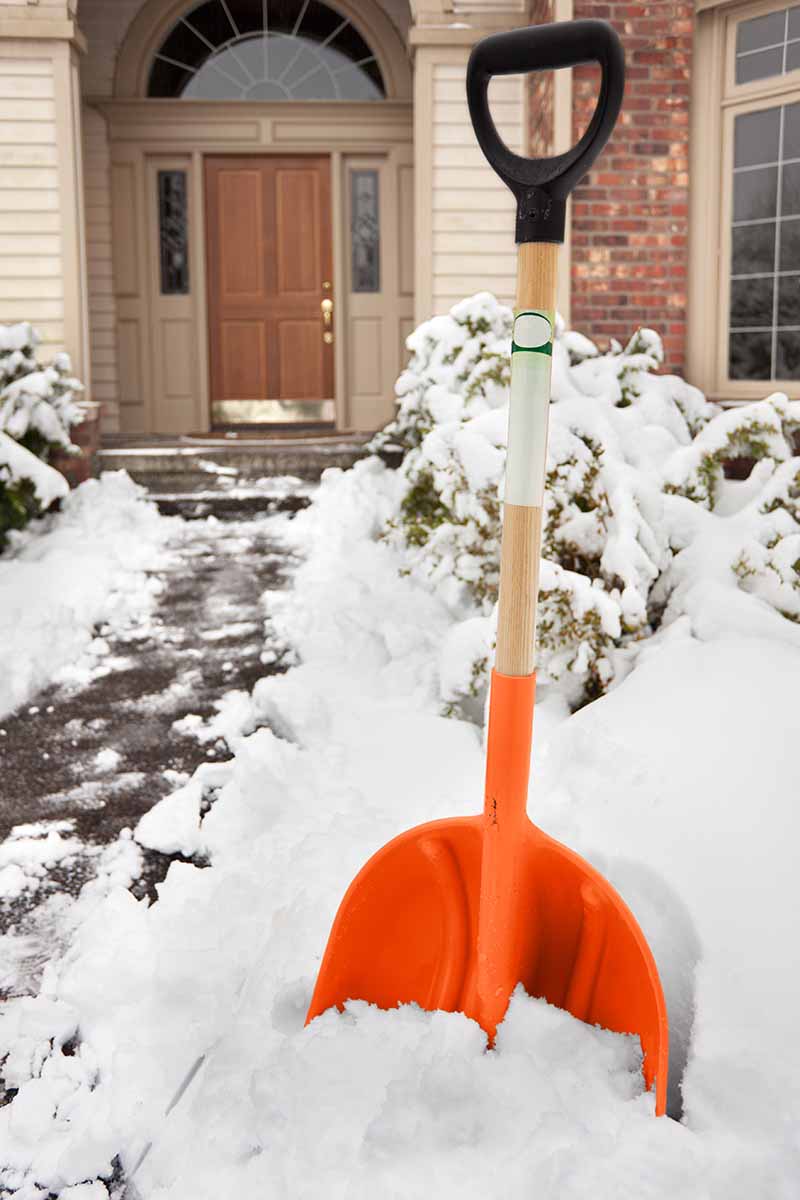
In addition to salt damage, the sheer weight of snow piled on top of the grass may cause compaction and bare spots. Avoid placing shoveled snow on the grass when possible. If you have no choice, spread it out.
By spreading the snow out instead of piling it high, you can not only minimize soil compaction, you can accelerate melting and inhibit mold formation as well.
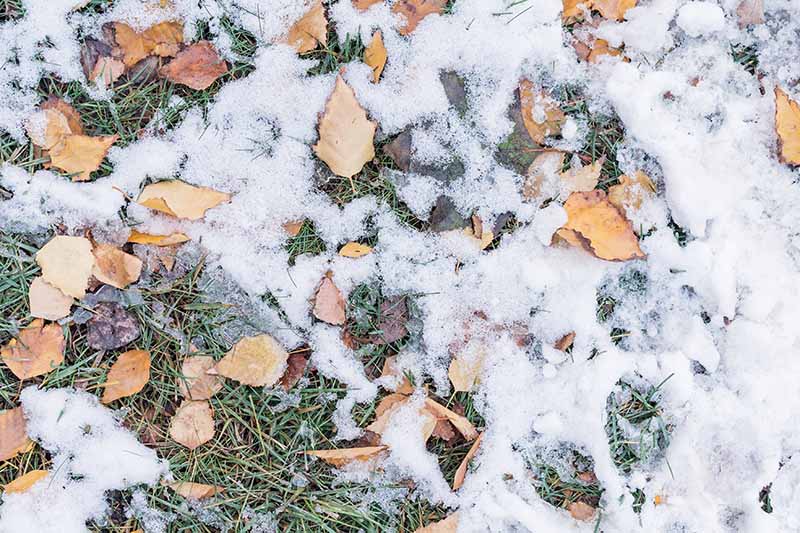
Another cause of soil compaction is parking cars on the grass. In my neighborhood in summertime, back yards are for barbecuing, but when the winter holidays arrive, they become staging areas for heavy-duty snowblowers, and overflow parking for overnight guests.
Keep this in mind, for the future health of your lawn.
A steady stream of foot traffic over your snowy lawn can also cause compaction. Try to limit snow play and do your walking on the sidewalks to avoid bare patches in the spring.
6. Mowing
If the cold weather came before you got that last cut in, that’s okay. On a dry day, you can still give your grass a final cut for the year.
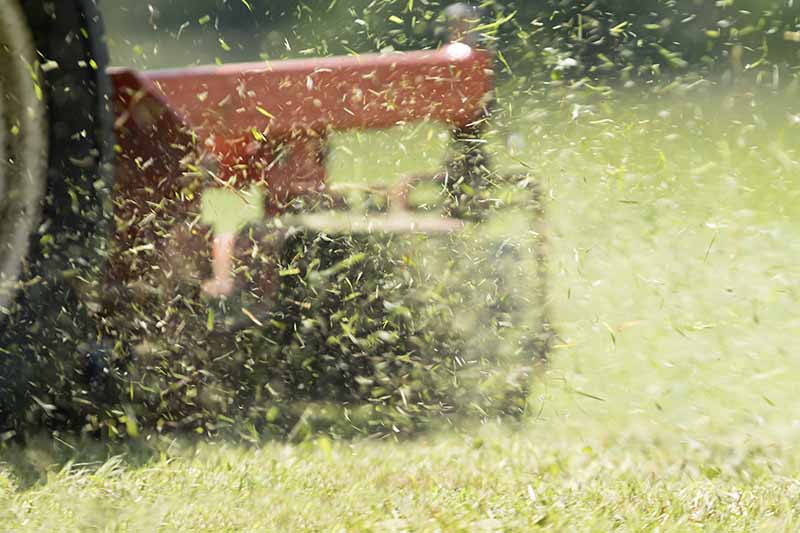
Clemson University’s Recommended Mowing Heights for Lawn Grasses suggests winter heights for warm-season zoysia of 1 to 2 inches, and cool-season perennial ryegrass heights of 1 to 2.5 inches.
You want your grass to be shorter in winter than during the summer in order to inhibit rodent infestation, especially of voles, as well as the formation of snow mold. Damage from both can mean more work in spring, repairing bare patches.
7. Raking
Raking is ongoing in my neighborhood because the trees all drop their leaves at different times, and sometimes we have snow before we’ve got them all raked up.
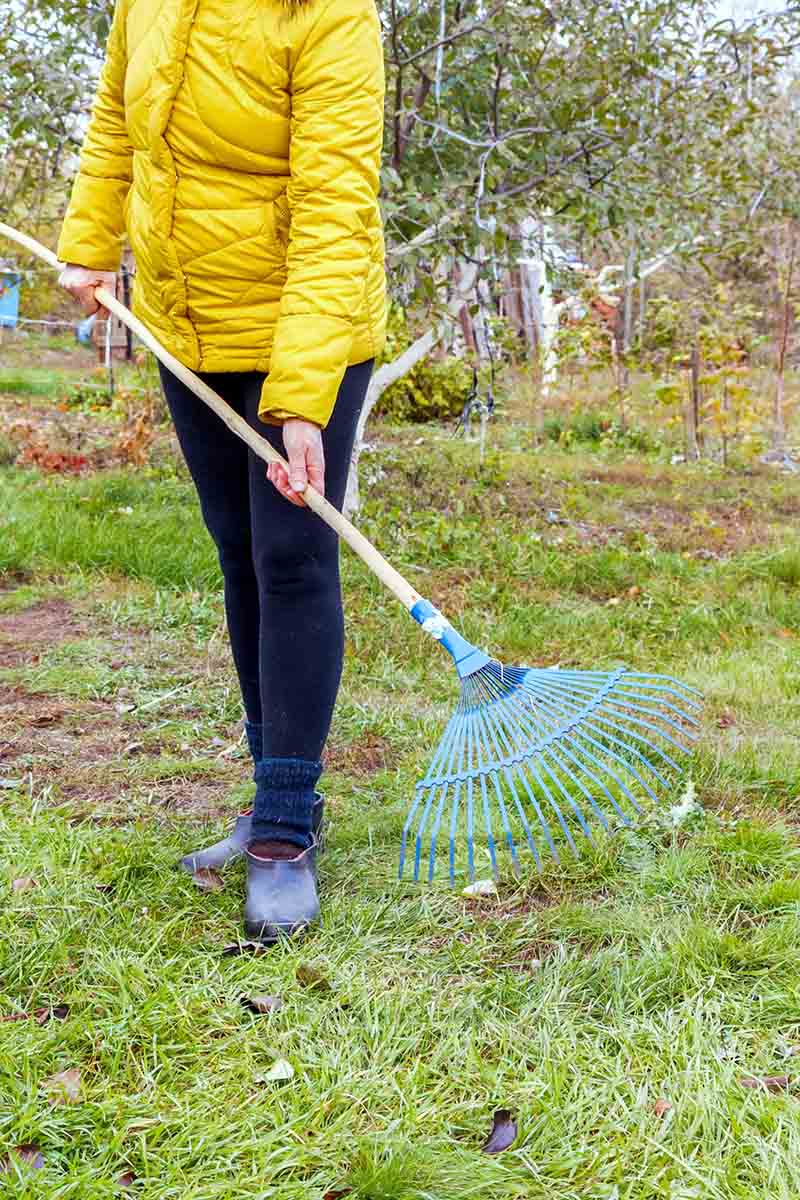
Winter is a fine time to finish (or start!) your autumn leaf cleanup. Wet leaves left on the lawn may lead to water buildup, fungal growth, pest infestation, and bare patches when the temperatures begin to rise again.
8. Removing Debris
The aftermath of a winter storm, particularly one with high winds and ice, often leaves properties littered with tree branches and other debris. And while you may not feel like braving the cold to clean up, it’s a good idea to do so.
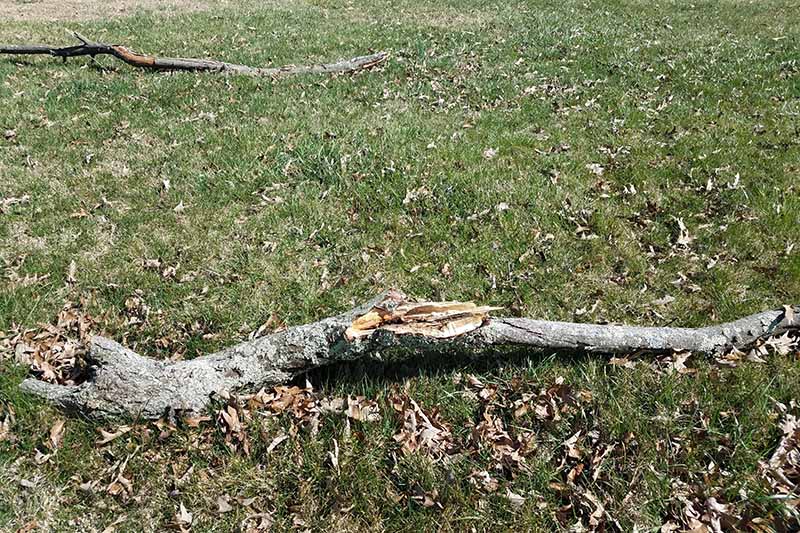
Heavy limbs on your grass can impede drainage, and cause crown hydration and soil compaction. Both of these are sure to lead to unwanted bare patches, but they’re easily preventable.
9. Seeding and Sodding
If you have existing bare patches that you just didn’t get to when the weather was warm, you can lay pieces of sod over them now to inhibit erosion and soil compaction. Do this on a day when the ground is above freezing, and water well.

Also, according to one of my favorite gardening guides, “Month-By-Month Gardening in Pennsylvania,” available from Amazon, you can spread seed during the coldest months of the year, even if there’s snow on the ground. What a great way to get a head start on repairing bare patches!

Month-By-Month Gardening in Pennsylvania
If you’re in the South, you can overseed your zoysia grass with annual ryegrass, for a green lawn through winter instead of a straw colored one.
This is usually done in the fall, but you can still give it a go in early winter. Just mow as low as you can go, spread seed, and wait for the green! As an annual, it will eventually die off and won’t compete with your zoysia as a perennial ryegrass would.
10. Watering
Snow isn’t the only winter weather that affects dormant grass. Sunshine, wind, and a lack of precipitation can dry out a lawn, or “desiccate,” especially in its first winter.
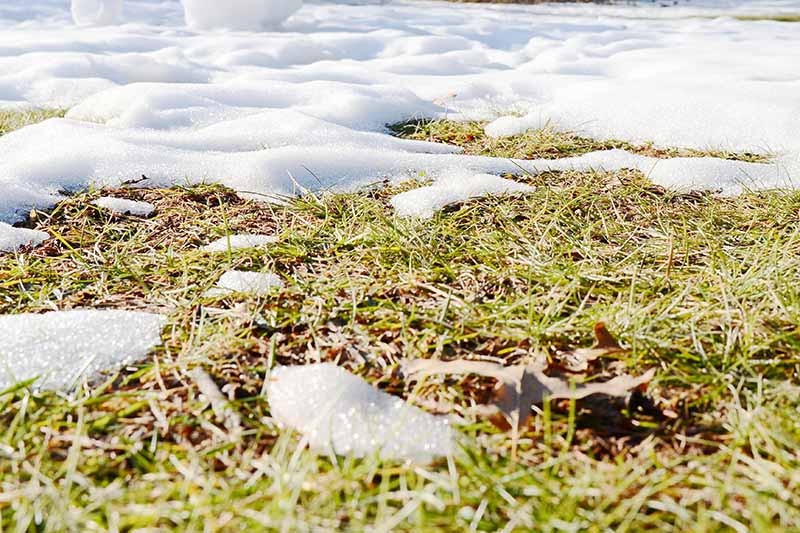
If you experience a winter drought, water deeply on a day that’s above 40°F. In addition to preventing death by dehydration, you may avoid damage caused by the microscopic, cool-season clover mite that is attracted to dry ground and likes to feed on turf close to buildings, leaving it damaged and discolored.
11. Weeding
Have you ever noticed that after a few mild, rainy winter days, weeds start to appear? They are especially evident when they pop up in the middle of an area of straw-colored zoysia grass. This is the perfect time to remove them and prevent them from gaining a foothold.
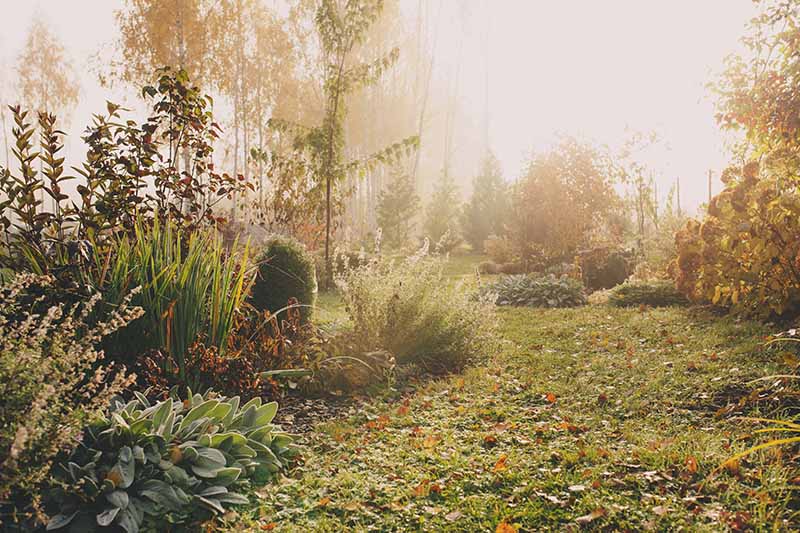
There is also a more aggressive approach that you can take – the application of a “pre-emergent” weed killer.
This is a product that inhibits weed growth before it even starts. It may be applied when the ground is not frozen.
Both methods can relieve you from aggressive weed eradication duties in the spring.
A Luscious Lawn, Come Spring
With these 11 essentials, you are likely to avoid “winterkill,” an umbrella term for the issues we’ve discussed, including soil compaction, crown hydration, snow molds, physiological drought, and desiccation.
Any or all of these may cause your grass to die during the coldest months of the year.
While most lawn care takes place between spring and fall, winter is still a good time to accomplish tasks such as aerating, amending, mowing, raking, seeding and sodding, watering, and weeding.
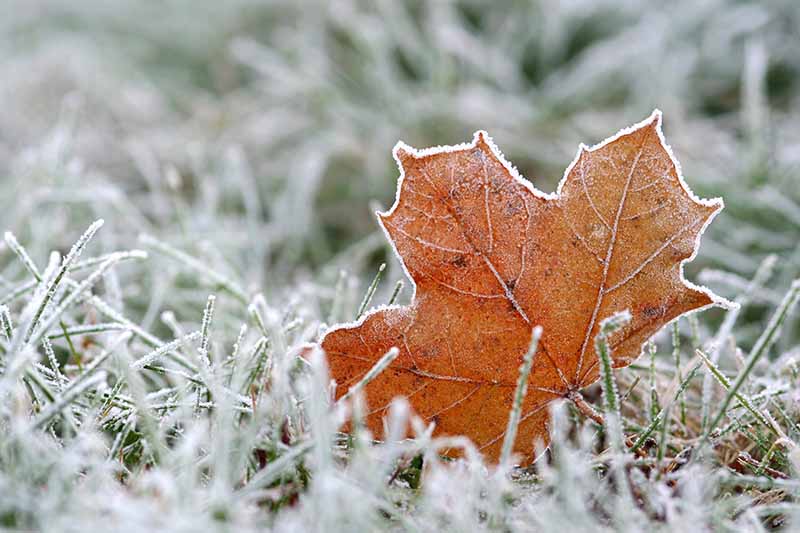
And consciously avoiding salt damage, soil compaction, and debris buildup, instead of leaving it to chance, goes a long way toward a healthy and attractive lawn.
Get outdoors this winter and enjoy some cold-weather lawn care. When your cheeks are rosier, your grass is greener, and your spring to-do list is shorter, you’ll be glad you did!
We love to hear from our readers. Please share your thoughts on winter lawn care in the comments section below.
For more lawn care tips and tricks, why not take a look at these guides next:
- Easy Landscaping with Ornamental Grasses: Simple Tips for Carefree Success
- Looking for a Luscious Lawn? Try These Tips to Get that Grass in Tip-Top Shape
- Why and How You Should Lime Your Lawn and Garden
© Ask the Experts, LLC. ALL RIGHTS RESERVED. See our TOS for more details. Product photo via Cool Springs Press. Uncredited photos: Shutterstock. With additional writing and editing by Clare Groom and Allison Sidhu.

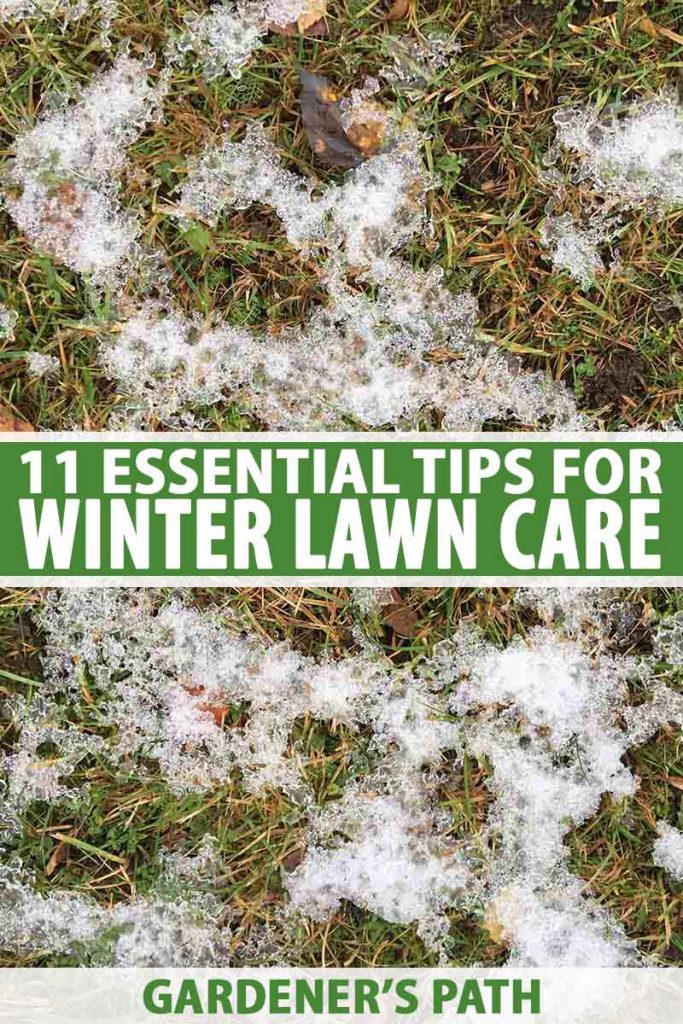
Thank you for sharing this awesome winter lawn care Very easy to follow. Worth sharing and reading.
Hello Landscaping Vancouver –
We’re so happy you like the article. Thank you for your comments.
Great lawn care tips! Thanks for sharing. Merry Christmas!
Hello Mason –
Thank you for your positive feedback. Happy New Year!
I have no idea that lime can reduced soil acidity. That’s amazing fact. Great share.
Hi Dumpster Rental –
We’re glad you found the article informative. Thanks for sharing.
I really enjoyed your post on lawn care essentials. I’m a big fan of keeping my lawn looking good too!
Hi Mark –
So happy to hear you enjoyed the article. Thanks for sharing.
Hello, I live in Pennsylvania. I have a sloped lawn where nutrients get washed away by heaven rain and other nourishment. My lawn soil seem to be getting dry rotted. Question Is, what can be the main cause of dried out rotted roots of my lawn. What does my lawn soil need to stay healthy?
What type of sand or solid should I apply to my lawn and when is the best time to do so.
Hello Veronica –
Growing grass on a slope is challenging because the soil erodes. In the spring, you can use a stiff garden rake (not a leaf rake) to remove the dead grass. Instead of reseeding the lawn, you might consider planting erosion control plants. If you have at least partial shade, you might try planting periwinkle, Vinca minor. This ground cover and others like it help to hold soil in place. Please see our article on flowering ground covering plants for more ideas.